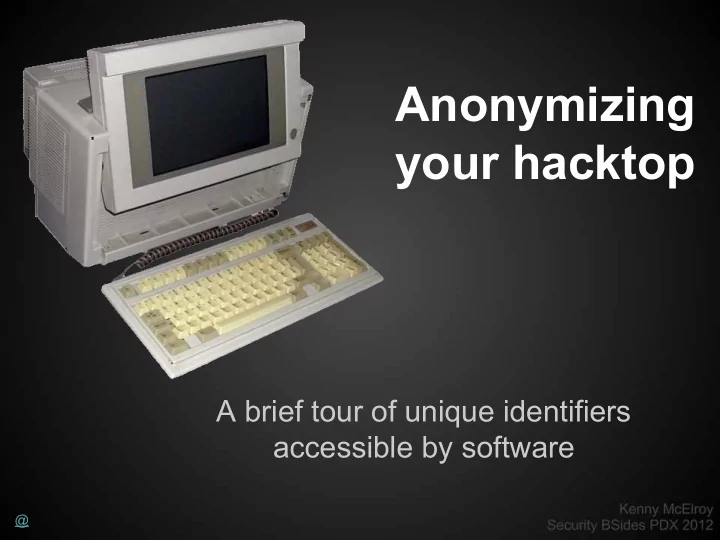

Anonymizing your hacktop A brief tour of unique identifiers accessible by software @
Unique Identifiers ● Who cares? ● What are we talking about? ● Where are they? ○ Laptops & Desktops ○ Peripherals ○ Smartphones ● Why change? ● How do we read/change them?
Who cares? ● Privacy advocates ● Anti-theft engineers ● Datacenter managers ● Equipment RMA departments ● Copy protection engineers ● European Parliament ● Even some end users
I'tell outside
What are we talking about? Unique identifiers in this presentation are: ● Small (~32 bytes or less) ● Not digests or fingerprints ● Persistent ● Defined by manufacturer
Where are they? (Laptops/Desktops) ● Motherboard Serial ● PCIe Device Serial Number ● DIMM SPD serial number ● Hard Disk Drive serial ● Network hardware addresses
Motherboard Serial ● Rarely unique on consumer products ● Defined in System Management BIOS spec ● Frequently stored on SPI flash
PCIe Device Serial Number ● Optional Enhanced Capability Header ● Not implemented in many PCIe devices ● 64-bit extended unique identifier ○ 24-bit company id assigned by IEEE ○ 40-bit extension identifier assigned by manufacturer ● Storage is implementation specific ○ Likely found on I²C/SPI EEPROM
Memory module serial number DDR3 DIMM SPD: ● 16-bit manufacturer ID ● 8-bit manufacture location ● 16-bit year/week of manufacture ● 32-bit serial number ● I²C* EEPROM *SMBus
Hard Disk Drive serial number ATA/ATAPI: ● 20 ASCII characters serial number ● 40 character model number SCSI: ● 8-byte Drive Serial Number ● 16-byte Product Identification
Network hardware addresses MAC-48 / EUI-48 48-bit address: ● Ethernet - 802.3* ● WiFi - 802.11* ● WiMax - 802.16* ● most IEEE 802 networks EUI-64 64-bit address: ● FireWire ● IPv6 ● ZigBee
Where are they? (Peripherals) ● Display EDID ● Software protection dongles ● RFID
Display EDID Extended Display Identification Data v1.3: ● 16-bit manufacturer ID ● 16-bit product ID ● 16-bit year/week of manufacture ● 32-bit serial number
Software protection dongles ● Tough to change, by design ● Easy to read
Where are they? (Smartphones) ● International Mobile Subscriber Identity ○ Country Code, Carrier Code, Subscriber Number ● GSM (T-Mobile, AT&T) ○ International Mobile Equipment Identity (handset) ○ Integrated Circuit Card IDentifier (SIM) ● CDMA (Sprint, Verizon, Cricket) ○ Mobile Equipment IDentifier ● Apple ○ Unique Device IDentifier
Why change? ● Well, you probably shouldn't ● Popular belief says you can't ● It will probably break stuff anyway ● What good will it do you?
How do we read them? Linux: Windows: ● lshw ● Device Manager ● dmidecode ● EVEREST ● hwinfo ● AIDA64 ● lspci -v ● lsusb -v
How do we change them? ● Software ● BusPirate ● GoodFET ● Arduino ● Just about any devkit
Questions? I would love to hear about your success stories ...or failures. kenny@romhat.net Who wants to have a workshop? Thanks!
Recommend
More recommend